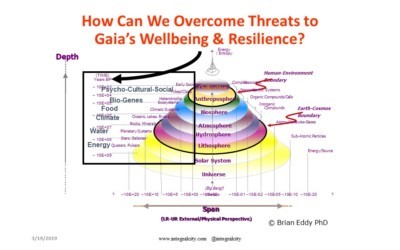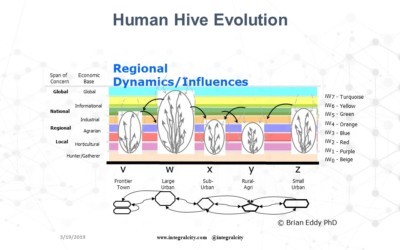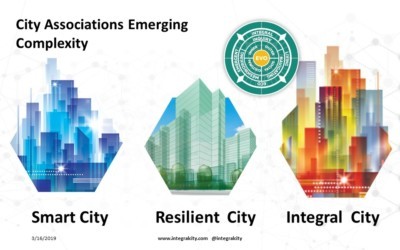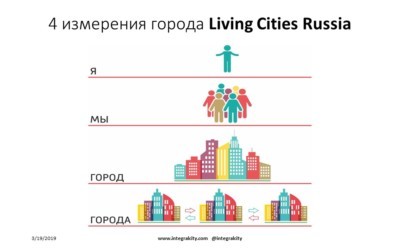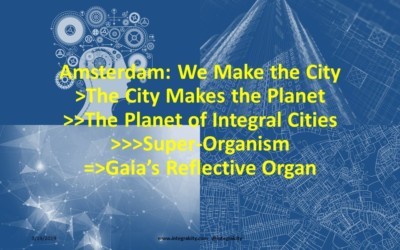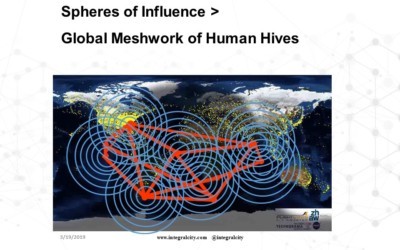Marilyn Hamilton's Blog, page 36
June 2, 2019
Integral City Consciousness at Climate Change Conference
From April 20 to 26 2019, Integral City’s Founder Marilyn Hamilton, immersed herself in the Climate Change and Consciousness Conference 2019 CCC19. With more than a month to consider the impact, we consider how the Integral City Intelligences reveal the capacities and outcomes of CCC19 in terms of Integral City inquiry, action and impact.

The intentions of the Climate Change and Consciousness Conference 2019 CCC19 were to leave a Legacy for Earth. The design of the conference brought together 300 people from around the world, with special resources allocated to bring in both youth and Indigenous representatives.
The intensity of the conference was brought home by a host of excellent keynote speakers, including Angaangaq Angakkorsuaq, Polly Higgins, Charles Eisenstein, Vandana Shiva, Bill McKibben, Jonathan Porritt and Xiutezcatl Martinez.
The themes for each day walked us through an integrally designed developmental process so we could listen deeply to the messages (It/Its), each other (You/We) and our selves (I/We):
Opening Night, Bill McKibben shared his disappointment with the world’s nations’ decade of failure to respond to the steady stream of facts and warnings related to CO2 emissions. (This was a more negative message than Paul Hawken’s Drawdown proposition that we have all the information needed to make 100 key changes even in the face of IPCC’s warning that we have 12 years to take measurable action – and that we considered in the pre-conference cChallenge.)
Day 2, Rising to Immediacy with Vandana Shiva’s no-nonsense message of “Soil not Oil”, emphatically describing the ways agriculture could be radically weaned off its industrialized methods back to natural and life-giving, higher yield agriculture.
Day 3, Awakening to Consciousness featured Charles Eisenstein’s commitment to Earth as a Living System. His book “Climate” argues for the same kind of natural agriculture as Vandana Shiva and the need to focus on the health of our water cycles even ahead of the carbonization priorities.
Also, Angaangaq Angakkorsuaq an Eskimo-Kalaallit Elder from far North Greenland shared ceremony with us to honour the beauty of every soul and every day.
Day 4, Listening to the Future brought us the wisdom and activism of 18 year old Xiutezcatl Martinez. He demonstrated that the younger generation is already taking action as Earth Guardians and like Greta Thunberg and Extinction Rebellion is not waiting for the older generations to wake up.
Day 5, Taking Responsibility was focused by Jonathan Porritt’s decades of political engagement challenging the status quo of corporate power bases.
Day 6, Stepping into Action was inspired by the last recording of Polly Higgins’ reminder that Climate Change demands action that is worth giving your life for.
Each of these speakers was erudite, inspiring and author of significant discourse, publications and media.
Polly Higgins, author of Eradicating Ecocide gave perhaps the strongest message, even as she died just as the conference started. But she made a convincing argument (on a recorded interview) that we must commit to protecting nature by enshrining crimes against the environment (ecocide) as an international crime through the Hague International Court for the Environment. (Her untiring dedication to this goal has positioned it to be taken to the next stage for acceptance and approval.)
The conference was designed so that participants had significant time for interaction with speakers and each other through Plenary World Cafes, break-out workshops and spontaneous Open Space sessions. Three of the most impactful – and unplanned events- arose with the Indigenous people and the youth.
Firstly Angaangaq, the Elder from Greenland, asked us “Why didn’t we listen” in 1963, when the elders said the “Big Ice” was melting. He went on to point out that the Amazon Rain Forest is the Earth’s lungs and the Big Ice is her temperature regulator. By destroying one we have altered the other and Earth is out of balance. He spoke truth to power in the plainest and most forceful way. ““Why didn’t we listen – it is too late now.”
The Indigenous asked for their rituals, protocols and lineages to be recognized in ways that they felt had been overlooked and disrespected. This resulted in a public apology to them that was very moving but was received by them with Grace and forgiveness.
The youth challenged the elders in the audience to stand up for them at Extinction Rebellion events by going to jail in place of the youth. Such a challenge really demanded that we “put our money where our mouth was”. Impressively, a significant number of elders stood up to confirm their willingness to sacrifice their “already well-lived lives” for a prison term (if necessary), so youth would not have their young lives marred by a prison sentence.
Now that I have had a chance to assimilate all that transpired at the conference, I have turned to the Integral City 12 Intelligences and assessed how the CCC19 experience demonstrated the necessity that cities be a vital part of the Climate Change initiatives (with pointing out instructions through the set of “rules” that support each intelligence). The next blog summarizes the assessment.
March 20, 2019
Integral City Reflective Organ – March 2019: Are Cities Evolving as Gaia’s Reflective Organs?

This newsletter is published quarterly using a cycle of perspectives on the Integral City viewed from: Planet, People, Place and Power. The theme of this issue is Planet.
… when we look at the scale of life on this planet, we notice that cities as human systems are in the center of the space between self and planet. As we look around the world it appears that higher-consciousness stages of We-space at various scales are increasingly active and prevalent as the next stage of evolution for human systems, including cities on the journey to becoming Integral Cities. As Integral City Community of Practice, we attend to action in the world related to the integral evolution of cities, noticing where Second Tier organizing principles are emerging in larger (communities and organizations) and smaller (teams and families) scales of human interaction. We are being invited to help individual cities evolve by working directly with a variety of emergent “We-fields.”
Hamilton, M. (2017). Integral City Inquiry & Action: Design Impact for the Human Hive. Phoenix, AZ: Integral Publishers, p.17
Scroll to end of newsletter to access Free Resources.
 How Might Cities Be Evolving as Gaia’s Reflective Organs?
How Might Cities Be Evolving as Gaia’s Reflective Organs?In early March, 2019 I had an opportunity to explore the question, “Are Cities Evolving as Gaia’s Reflective Organs?” My audience was an erudite gathering of the online 3 Horizons University (3Huni for short).
I proposed to explore the case for the evolution of cities, not as a bane on the Earth, but as a necessary stage of maturing capacity of Gaia’s living system. I offered evidence from science, thought experiments and practice, from my Integral City Book Series, Reframing Complex Challenges for Gaia’s Human Hives (2018), Inquiry and Action: Designing Impact for the Human Hive (2017) and Integral City: Evolutionary Intelligences for the Human Hive (English 2008, Russian 2014).
Macro and Micro Science
My curiosity has long been piqued by James Lovelock, author of the Gaia Hypothesis – that the Earth is a living system. Also, Elisabet Sahtouris, Evolution Biologist. The former speaks to the macro scale of life on our planet. The latter speaks to the micro scale and how the qualities of living systems at all scales reveal self-same patterns or fractals.
Elisabet wrote in the Foreword to the new edition (upcoming) of Integral City: Evolutionary Intelligences for the Human Hive, sharing an experience that we have had in common.
Looking down on Earth’s surface from an airplane, whether by day or night, our cities look remarkably like cells—nucleated cells, with their obvious nuclear ‘downtown’ hubs, scattered smaller concentrations of buildings like cell organelles, flowing transport systems, extensions into the surround like the pseudopods of amoebae.
This has struck me again and again in flying around Earth as an evolution biologist and futurist seeking answers to our big questions on whence, we came and where we are headed, all the while teaching my evolving take on them. Eventually I realized that cities were indeed living entities, and now undergoing a rapid evolution comparable to the origins of the nucleated cells they so resemble.
Lovelock imagines that Gaia is evolving for herself a “Reflective Organ” through the evolution of human beings. Sahtouris observes that the process of maturiing the human species is passing through early stages of consumption and competition. She points out that as our species matures it will recognize that both these stages consume too much energy (i.e. they cost too much in terms of the relationship of the input of energy to the output of sustainable and resilient results). Sahtouris contends that we are waking up to the energetic equation that collaboration costs much less energy than conflict, wars and pillaging resources, and is the evolutionary intelligent behaviour to enact.
When we see the havoc that humans have created on Earth as we evolve through the early stages of our species growth cycle, it is easy to imagine (as most people do) that Humans are the bane of Gaia’s existence. Our cities tend to be heaped with special blame because they accumulate and concentrate so much wealth. In Book 3 of the Integral City series, I note the veritable vortex of threats that we have created as we have drawn down on the planetary layers of resources (see Figure).
Our VUCA Vortex (volatile, uncertain, complex, ambiguous) is whirling around our cities manifesting threats to our quality of life through challenges that are becoming increasingly intelligently documented. The following list names the big challenges and key authors who have explored the data and the implications.
Financial Upheaval (Esborn-Hargens, Raworth, Henderson, McCrum, McLeod)
Energy (Monbiot)
Water Scarcity (Linton)
Climate (O’Brien, IPCC, Hawken, Lester Brown)
Environment/Ecology (Esborn-Hargens / Zimmerman, Taylor)
Food Scarcity (McKibben, Taylor)
Collapse (Diamond, Wright, Hawken)
When we plot these threats on a cosmology of the evolution of the Universe it looks something like this.
Yet, when we look at key city discourses through the lenses of Sustainable Development Goals (UN), Scale (G. West) or Urban Crisis (R. Florida) we can read excellent analyses of indicators, infrastructures and environmental degradation. But we are hard pressed to find how these authors imagine the vital contributions of consciousness and culture to solving complex problems let alone relating them within a context of evolutionary development. In short, these core frameworks do NOT include a developmental dimension. By contrast, Integral City proposes that cities are not developmentally “flat” or “steady state” but emerge and change and shapeshift in all their internal and external contexts over time. As a result of this understanding the evolutionary dynamic and its impact on the quality of life in cities, we can open up to ever more complexity and possibilities for the human hive – rather than contracting or shrinking away from such change.
Integral City frames its view of the world through developmental lenses, seeing that individuals and collectives all traverse lifecycles of maturing that produce capacities and intelligences at every scale of human system from individual to family/team, organization, sector, community and the city. The patterns that these different scales exhibit consciously and culturally reveal the fractalness that Sahtouris has noticed through the biological and systems perspective. Thus, the five sets of intelligences that cities, as living systems, have evolved keep them alive, connected to their environments (sustainable) and regenerating (Capra, Wahl).
Read the complete editorial in the following 4 blogs.
Are Cities Evolving as Gaia’s Reflective Organs?
Thought Experiments – Listening & Learning from Bees
Integral City Maps, Intelligences, Emergent Practices for Gaia
Evidence for Big Bite & Hope for Gaia?
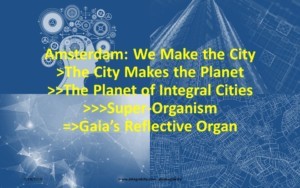 Upcoming Events for Integral City
Upcoming Events for Integral CityBeyond Smart: Integral City Practices, Tools & Maps
For Practitioners. (2 Days, Findhorn, Scotland, April 27-29, 2019)
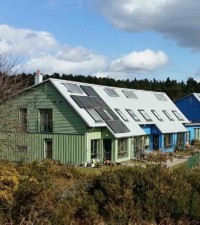 This 2-day course introduces “practitioners” to just the basics of the Integral City model. You will learn the framework of practices, tools and maps that reveal the common patterns that impact the lives of individuals, organizations and communities within your city. This short course explores three powerful images animating Integral City systems – the integral map, the meshwork and the human hive. You will learn from your own situations and each other how the toolkit guides you beyond models for Urban Ecovillages and Traditional, Smart and Resilient Cities.
This 2-day course introduces “practitioners” to just the basics of the Integral City model. You will learn the framework of practices, tools and maps that reveal the common patterns that impact the lives of individuals, organizations and communities within your city. This short course explores three powerful images animating Integral City systems – the integral map, the meshwork and the human hive. You will learn from your own situations and each other how the toolkit guides you beyond models for Urban Ecovillages and Traditional, Smart and Resilient Cities.
MORE INFO
Beyond Resilient: Integral City Inquiry Action & Impact
For Catalysts. (4 Days, Findhorn, Scotland, May 1-4, 2019)
 This 4-day course is for “catalysts” to explore inquiry and action that inspires productive impact for reinventing today’s cities for the future. You will interact with the 4+1 Voices of the Integral City (Business, Local Government, Civil Society and Citizens, plus actors from other regional cities) to identify strategic possibilities. Integral City introduces you to new ways to think about, act in, relate to and reinvent the city as a Human Hive. Through placecaring and placemaking, we invite you to discover the unique contributions you make to its aliveness. We believe the future of cities will emerge not just from the bottom up through Smart City Technology or the top down through Resilient approaches – but from the integrated actions of the 4+1 Voices in all the cities in your eco-region, as you reinvent your Human Hives. MORE INFO
This 4-day course is for “catalysts” to explore inquiry and action that inspires productive impact for reinventing today’s cities for the future. You will interact with the 4+1 Voices of the Integral City (Business, Local Government, Civil Society and Citizens, plus actors from other regional cities) to identify strategic possibilities. Integral City introduces you to new ways to think about, act in, relate to and reinvent the city as a Human Hive. Through placecaring and placemaking, we invite you to discover the unique contributions you make to its aliveness. We believe the future of cities will emerge not just from the bottom up through Smart City Technology or the top down through Resilient approaches – but from the integrated actions of the 4+1 Voices in all the cities in your eco-region, as you reinvent your Human Hives. MORE INFO
Beyond Complexity: Integral City Care Context & Capacity
For Meshworkers. (4 Days, Findhorn, Scotland, Sept. 14-17, 2019)
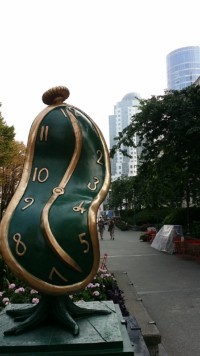 This 4-day course is for “meshworkers” to imagine how to reframe simplicity on the other side of complexity in the Integral City – or Human Hive. You will join graduates of prior training to build on the Integral City practitioner and catalyst competencies to apply new skills to a live case study. You will look at the city through the lenses of Care, Contexting and Capacity Building. You will view the city as a complex, adaptive living innovation eco-system, where the internal and external connections amongst the 4+1 voices of the city (Citizens, Civil Society, City/Institutional Managers, Business/Innovators (and other cities) enable conditions for thriving today. You will seek to align intra-city and inter-regional collaborations through caring for people, contexting for place and capacity building for purpose. This course introduces the practices of “meshworking”, so that practitioners who work with individual organizations and catalysts who build bridges between organizations can engage with the city as a whole. MORE INFO
This 4-day course is for “meshworkers” to imagine how to reframe simplicity on the other side of complexity in the Integral City – or Human Hive. You will join graduates of prior training to build on the Integral City practitioner and catalyst competencies to apply new skills to a live case study. You will look at the city through the lenses of Care, Contexting and Capacity Building. You will view the city as a complex, adaptive living innovation eco-system, where the internal and external connections amongst the 4+1 voices of the city (Citizens, Civil Society, City/Institutional Managers, Business/Innovators (and other cities) enable conditions for thriving today. You will seek to align intra-city and inter-regional collaborations through caring for people, contexting for place and capacity building for purpose. This course introduces the practices of “meshworking”, so that practitioners who work with individual organizations and catalysts who build bridges between organizations can engage with the city as a whole. MORE INFO
Integral City Book 3 in the Bookstores
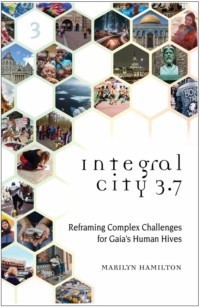 Integral City 3.7: Reframing Complex Challenges for Gaia’s Human Hives Book 3 in the Integral City series, considers a series of apparently intractable challenges that all cities face because the world has become so complex that cause and effect are rarely directly linked. The challenges cities face today result from the intertwining impacts of multiple life conditions, perspectives and capacities and can only be addressed by reframing them within an Integral City model that honors the plural realities, recognizes their developmental and evolutionary relationships and does not conflate differences.
Integral City 3.7: Reframing Complex Challenges for Gaia’s Human Hives Book 3 in the Integral City series, considers a series of apparently intractable challenges that all cities face because the world has become so complex that cause and effect are rarely directly linked. The challenges cities face today result from the intertwining impacts of multiple life conditions, perspectives and capacities and can only be addressed by reframing them within an Integral City model that honors the plural realities, recognizes their developmental and evolutionary relationships and does not conflate differences.
This third book in our series explores three themes that are eternal practices for designing a collective life that works for all life; namely, Caring, Contexting and Capacity Building. The book starts Part 1: Deepening Care with the “missing chapter” from Integral City Book 1 and adds a new Map (5) – “Spirituality in the Human Hive”. It explains the intimate relationship between Caring Capacity and Carrying Capacity as strategic factors that contribute to sustainable and resilient cities. Part 2: Raising Context makes a persuasive case for the city as both a trigger point and a tipping point for evolution on our Planet of Cities. Part 3: Widening Capacity examines the emergence of capacity across a holarchy of human scales: leaders, organizations, systems and city.The book concludes with a synthesis of the relationships between Caring and Contexting as they are expressed in Integral Capacities at multiple scales within the human hive.
The book’s generational number “3.7” reminds us of the 7th generation in the future, a time span that many indigenous people consider relevant to contexting and making wise decisions. The dedication to the seventh generation from now activates an “overview effect” that forces us to consider the consequences of our cities’ impact on our living planet, Gaia.
Celebrating Planet-of-Cities in the Coming Quarter of 2019
Between darkness and light I will always walk, and everywhere that I walk, I will open a window of light and plant a seed of love. (Taize verse)
March 20 marks the start of what Integral City calls the Planet Quarter (from March 20 to June 21). What disturbances darken the path of your planetary experience? What light shines through despite the sometimes conflicted path of our species’ evolution on this emerging Planet of Cities? What landscapes fill you with despair? What vistas inspire you with eternal hope? We are noticing the leadership roles that cities are initiating to demand changes to plastic cycles/recycles; that C40 women mayors under the banner of #women4climate are standing up for climate; and youth like Greta Thunberg are demanding eco-justice for all life on this planet. Visit us on the our Integral City Website and Blog or post a comment on our Facebook page, about your passion for our planet of cities as she calls us to become her Reflective Organs.
Meshful Blessings of this Equinox for our Planet of Cities from
Marilyn Hamilton and the Integral City Constellation Corps Team
PS Here are some FREE resources for nurturing our Planet and her Human Hives:
1. Podcast
Sean Esborn-Hargens: A Conversation With Metaimpact
2. Why Come to Findhorn for Integral City Training?
Tamarack: Open Letter from Integral City Beyond Resilient Beyond Smart
3. BLOGS
The Knowing Field and Constellating for the Collective
The Manifesto of New Sincerity
Are Cities Evolving?
Are Cities Evolving as Gaia’s Reflective Organs?
Thought Experiments – Listening & Learning from Bees
Integral City Maps, Intelligences, Emergent Practices for Gaia
Evidence for Big Bite & Hope for Gaia?
Climate Change
How Do You and I Make Drawdown Personal?
cChallenge Draws On & Creates MetaCapitals
New Perspectives on Beauty, Goodness and Truth from ccc19 cChallenge
Meta-Findhorn 4+1 Voices Think Cosmically, Feel Globally, Act Locally
Welcome to the Restaurant at the end of ccc19 cChallenge
4. Enlivening Organizations for Teal/Yellow Development
How Do Organizations Enliven the City?
Are you a Member of the 10%
5. Newsletters Past Issues 2018
Integral City MetaBlog 2018 – A synthesis and index of all Integral City Blogs from 2018.
Integral Cities of the Year 2018 – 6 AIKA – for the collaborative city spirit amongst 6 cities in Finland.
Meshworker of the Year Award 2018 – Diana Claire Douglas for Systemic Constellation Work for the Collective.
Integral City Reflective Organ – December Solstice 2018: Reframing Complex Challenges with the Power to Change
Integral City Reflective Organ – September Equinox 2018: Wholing, Including, Emerging, Evolving
Integral City Reflective Organ – June Solstice 2018: Evolutionary Allies Placecare & Placemake the Human Hive
Integral City Reflective Organ – March 2018: Eco-Villages, Human Hives and Gaia’s Reflective Organs
Are you a Member of the 10%?
This article by Marilyn Hamilton was published in Enlivening Edge Magazine, March 5, 2019

In my descriptions of cities as living systems, it’s clear that the wellbeing of the city depends on the wellbeing of its organizations and its citizens. Moreover, the development and evolution of the city into something approaching an Integral/Teal City, depends on the development and evolution of Integral/Teal organizations who in turn depend on the development and evolution of Integral/Teal individuals.
Thus, organizational developers themselves are dependent on an ecology of colleagues who work with individuals to develop their capacities. They are also dependent on cross-sectoral colleagues who work in the public, private and NFP sectors to develop other organizations—all connected in the web of life.
What makes a system a “living” system?
According to Miller (1) the same three major systems and nineteen sub-systems are fractal patterns shared across all living systems.
These perform functions to metabolize:
Energy/Matter/information
Energy/Matter
Information
According to Capra (2) living systems demonstrate three patterns:
They survive (sustaining themselves as entities fulfilling distinctive purposes).
They reproduce or regenerate (enabling resiliency, learning and development).
They connect with their environment (adapting and co-creating their contexts).
Click here to read the whole article.
March 19, 2019
Evidence for Big Bite & Hope for Gaia?
In early March I had an opportunity to explore the question, “Are Cities Evolving as Gaia’s Reflective Organs?” My audience was an erudite gathering of the online 3 Horizons University (3Huni for short).
I proposed to explore the case for the evolution of cities, not as a bane on the Earth, but as a necessary stage of maturing capacity of Gaia’s living system. I offered evidence from science, thought experiments and practice, from my Integral City Book Series, Reframing Complex Challenges for Gaia’s Human Hives (2018), Inquiry and Action: Designing Impact for the Human Hive (2017) and Integral City: Evolutionary Intelligences for the Human Hive (English 2008, Russian 2014).
This is blog 4 of a 4-part blog series – to continue to the next instalments click on the links at the bottom of the blog.
 Where is the Evidence?
Where is the Evidence?Now we have taken off a big bite considering the evidence of science, the provocation of thought experiments and the exploration of evolutionary maps.
Is it time to look around us and notice the emergence of Integral Cities through growing “Place” Practices … from community to city to planet of cities to Integral City to Planet of Integral Cities? With just brief nods in three directions, let us consider these examples.
One of the first people who demonstrate for me the evolutionary patterns of city maturation was, Integral Geographer, Dr. Brian Eddy (the author of our cosmology map above). He mapped out urban development as in Figure below.
Evidence:
2. The second set of evidence comes from the emergence of city associations, that I have been tracking as Smart, Resilient, Integral cities as in Figure below.
Evidence:
3. Finally, the third set of evidence comes from Living Cities Russia who have nicely graphed the emergence of the Master Code in the diagram in Figure below.
Evidence:
Hope for Gaia from Science, Thought Experiments, Maps
My concluding comments come from the inspiration of the Amsterdam Festival 2018 called “We Make the City”. From here I could conclude
Amsterdam: We Make the City
>The City Makes the Planet
>>The Planet evolves Integral Cities
>>> Integral Cities become a Super-Organism
=>Which in turn becomes Gaia’s Reflective Organ
For by reflectively practising the Master Code of Care not only as individuals but as collectives – especially in human hives – humans become a super-organism of reflective Care for the Earth. Another way to say this is that our cities become Gaia’s Reflective Organs of Care (reflecting her Beauty, Truth and Goodness).
It is our job to grow, develop and evolve ourselves, not just as individual human hive organs, but as a collective system to provide Gaia a Reflective Organ System – an organ system who can share stories about a Planet of Integral Cities Who Care.
When will this happen? When Will Human Hives Become Planetary Meshwork of Gaia’s Reflective Organs? Whether it is 2119? 2519? 3019? we are on the evolutionary path to that miraculous emergence.
This blog series explores science, thought experiments and maps to inquire if “Cities are Becoming Gaia’s Reflective Organs?”
Are Cities Evolving as Gaia’s Reflective Organs?
Thought Experiments – Listening & Learning from Bees
Integral City Maps, Intelligences, Emergent Practices for Gaia
Evidence for Big Bite & Hope for Gaia
Integral City Maps, Intelligences, Emergent Practices for Gaia
In early March I had an opportunity to explore the question, “Are Cities Evolving as Gaia’s Reflective Organs?” My audience was an erudite gathering of the online 3 Horizons University (3Huni for short).
I proposed to explore the case for the evolution of cities, not as a bane on the Earth, but as a necessary stage of maturing capacity of Gaia’s living system. I offered evidence from science, thought experiments and practice, from my Integral City Book Series, Reframing Complex Challenges for Gaia’s Human Hives (2018), Inquiry and Action: Designing Impact for the Human Hive (2017) and Integral City: Evolutionary Intelligences for the Human Hive (English 2008, Russian 2014).
This is blog 3 of a 4-part blog series – to continue to the next instalments click on the links at the bottom of the blog.
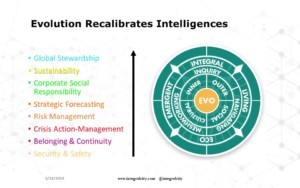
Integral City Maps, Intelligences, Emergent Practices
When we confront the implication of the terrible lesson of Colony Collapse Disorder (CCD) discussed in the previous blog, it is a consolation to consider, what Sahtouris teaches about the stages of species evolution (noted above). The crux of her pointing-out instructions is that evolution recalibrates intelligences when life conditions become critical to survival. It is through these dissonances to our system that greater complexity emerges as we adapt to survive under changing life conditions. That is how we develop an unfolding set of Values and the Intelligences that go with them (see Figure Evolution Recalibrates…).
The Integral City set of 10 Intelligences that reflect these deepening values, has been designed into a GPS. At the heart of this GPS lies the Evolutionary Intelligence which we define this way:
Evolutionary Intelligence is the capacity to transcend and include the intelligences we currently demonstrate, in order to allow new intelligences to emerge….
With our science and thought experiments unpacked, we can now use this GPS to fashion 5 shapeshifting maps for the city as it appears to be evolving into Gaia’s Reflective Organ. Maps 2-3-4-5 are shapeshifts of Map 1. As a result, each map offers different and complementary lenses for seeing wholeness in the human hive. For wholeness is a quality that Gaia’s Reflective Organ can offer to a planet wanting to become conscious of itself. (see Figure set of 5 maps).
I have described these maps in many places elsewhere (Books 1, 2, 3 and blogs). Each one reveals qualities vital to the successful functioning of a Reflective Organ – quadrants, complex structures, holarchical structures, fractals, co-existing organelles, energetic flows, field effects.
The maps reveal slices, views, pulses, relationships and dynamics of the city that are breathtaking in their beauty (truth and goodness) and mysterious in their impact by, with and as the quality of Love appears to be their source. This starts as a very practical Love arising from our willingness to care for self, each other, place and planet. I have called this the Master Code of Care and it is fundamental to the emergence of humans as Gaia’s Reflective Organ. For this evolving organ will not merely reflect observations, thoughts, emotions or even spirit – it will reflect the core capacity for human relationships and for the Planet’s evolution as a conscious and caring living system. For, like the human embryo developing in utero, the brain unfolds from the heart (and we are learning the heart sends more neural signals to the brain than the other way around). Thus the development of the heart and then the mind/brain is what the evolutionary path for Gaia’s Reflective Organ is likely to be (assuming the habits of living systems are repeated at the largest planetary scale).
Perhaps the development of another Integral City intelligence will enable that to happen? We call it Meshworking Intelligence and have focused more on the functioning of Meshworking in the brain. Meshworking Intelligence that creates a “meshwork” by:
Weaving together the best of 2 operating systems – Self-Organizing Systems (SOS) & Structures; and
Aligning complex responsive structures that flex and flow in a hierarchy of complexity.
The resulting Meshwork has the capacity for simultaneously functioning for:
Resilience by responding to dissonance triggers as a SOS; and
Sustainable Structures by sorting & selecting options.
Thus Meshworking Creative strategies has the potential to solve all of our big challenges (as noted above).
What is more we must ask ourselves if the powerful combination of the Master Code functioning as a Meshwork is already happening at the city scale? We can even ask:
Is the City Itself a Meshwork?
It connects individuals into groups …
Groups Create a Network
Networks Create Communities of Practice (COP)
COP Transform into Spheres of Influence
Spheres of Influence can become
Global Meshwork of Human Hives
With this set of evolutionary patterns, it appears that Meshworking could deliver Local Action – Global Feeling -Cosmic Thinking (as Jude Currivan conjectures in Cosmic Hologram).
This blog series explores science, thought experiments and maps to inquire if “Cities are Becoming Gaia’s Reflective Organs?”
Are Cities Evolving as Gaia’s Reflective Organs?
Thought Experiments – Listening & Learning from Bees
Integral City Maps, Intelligences, Emergent Practices for Gaia
Evidence for Big Bite & Hope for Gaia
Thought Experiments – Listening & Learning from Bees
In early March I had an opportunity to explore the question, “Are Cities Evolving as Gaia’s Reflective Organs?” My audience was an erudite gathering of the online 3 Horizons University (3Huni for short).
I proposed to explore the case for the evolution of cities, not as a bane on the Earth, but as a necessary stage of maturing capacity of Gaia’s living system. I offered evidence from science, thought experiments and practice, from my Integral City Book Series, Reframing Complex Challenges for Gaia’s Human Hives (2018), Inquiry and Action: Designing Impact for the Human Hive (2017) and Integral City: Evolutionary Intelligences for the Human Hive (English 2008, Russian 2014).
This is blog 2 of a 4-part blog series – to continue to the next instalments click on the links at the bottom of the blog.

Beyond the sciences of physics, biology, evolution and social systems, further insights accrue to the understanding of cities as “human hives” by studying the biomimicry lessons of the beehive. Effectively the bee hive prototypes the human hive – demonstrating the full set of 12 intelligences (as I have written elsewhere).
To summarize the key points that Apis Mellifera offers us:
Apis Mellifera system reflects Nature’s experiment for 100 million years – thus they are exponentially more mature as a species than humans.
In their evolution of 100 Million years, bees have developed a “hive goal” to produce 20 kg honey per year in order to survive. They use sophisticated forms of complexity, communication (not only their waggle dance but through chemical transfers) and course correction to create a “hive mind” that serves the simultaneous wellbeing of individuals and the collective of 50,000 bees in the hive.
Honey bees have developed 4 Internal Roles and a 5th External Role to accomplish their intentions. The 4 Internal Roles of Forager-Producer, Diversity Generator, Resource Allocator and Inner Judge suggest that human patterns suggest we consider the contributions of 4 Voices in the human hive: Citizens, Business/Innovators, Civic Managers and Third Sector and learn how to align them for sustainable and resilient outcomes.
The 5th Role of the bee hive is external. It is called “Intergroup Competitor” and contributes to the advancement of hive resilience by ensuring the species does not eliminate competition but instead transcends and includes it so that the best hives survive to perpetuate the species.
The bees have a purpose that encompasses their annual production targets and also serves their ecoregion by pollinating all the plants to ensure that their renewable energy resources will be available not just for this year but for next year. In this way bees align Placecaring & Placemaking on two scales – one for the hive itself, and the other for the eco-region with which they co-exist. Cities need to take the same lessons so that they are living the same double sustainability loop of not just accumulating wealth but returning it in circular economies to enable the wellbeing of the eco-region(s) that support them.
Although this cross-species learning may seem like a fanciful thought experiment, it becomes much more than a nice story, when we consider the dire consequences of the threat to the bee hives that we call Colony Collapse Disorder (CCD). Surely, this aspect of our biomimicry lesson from the bees, must give humans a warning that we pay attention to the Vortex of VUCA conditions mentioned above. Because it seems that bees are experiencing an eerily similar pattern to the VUCA vortex that humans face (as seen in Figure of CCD above).
This blog series explores science, thought experiments and maps to inquire if “Cities are Becoming Gaia’s Reflective Organs?”
Are Cities Evolving as Gaia’s Reflective Organs?
Thought Experiments – Listening & Learning from Bees
Integral City Maps, Intelligences, Emergent Practices for Gaia
Evidence for Big Bite & Hope for Gaia
Are Cities Evolving as Gaia’s Reflective Organs?
In early March I had an opportunity to explore the question, “Are Cities Evolving as Gaia’s Reflective Organs?” My audience was an erudite gathering of the online 3 Horizons University (3Huni for short).
I proposed to explore the case for the evolution of cities, not as a bane on the Earth, but as a necessary stage of maturing capacity of Gaia’s living system. I offered evidence from science, thought experiments and practice, from my Integral City Book Series, Reframing Complex Challenges for Gaia’s Human Hives (2018), Inquiry and Action: Designing Impact for the Human Hive (2017) and Integral City: Evolutionary Intelligences for the Human Hive (English 2008, Russian 2014).
This is blog 1 of a 4-part blog series – to continue to the next instalments click on the links at the bottom of the blog.

Macro and Micro Science
My curiosity has long been piqued by James Lovelock, author of the Gaia Hypothesis – that the Earth is a living system. Also, Elisabet Sahtouris, Evolution Biologist. The former speaks to the macro scale of life on our planet. The latter speaks to the micro scale and how the qualities of living systems at all scales reveal self-same patterns or fractals.
Elisabet wrote in the Foreword to the new edition (upcoming) of Integral City: Evolutionary Intelligences for the Human Hive, sharing an experience that we have had in common.
Looking down on Earth’s surface from an airplane, whether by day or night, our cities look remarkably like cells—nucleated cells, with their obvious nuclear ‘downtown’ hubs, scattered smaller concentrations of buildings like cell organelles, flowing transport systems, extensions into the surround like the pseudopods of amoebae.
This has struck me again and again in flying around Earth as an evolution biologist and futurist seeking answers to our big questions on whence, we came and where we are headed, all the while teaching my evolving take on them. Eventually I realized that cities were indeed living entities, and now undergoing a rapid evolution comparable to the origins of the nucleated cells they so resemble.
Lovelock imagines that Gaia is evolving for herself a “Reflective Organ” through the evolution of human beings. Sahtouris observes that the process of maturiing the human species is passing through early stages of consumption and competition. She points out that as our species matures it will recognize that both these stages consume too much energy (i.e. they cost too much in terms of the relationship of the input of energy to the output of sustainable and resilient results). Sahtouris contends that we are waking up to the energetic equation that collaboration costs much less energy than conflict, wars and pillaging resources, and is the evolutionary intelligent behaviour to enact.
When we see the havoc that humans have created on Earth as we evolve through the early stages of our species growth cycle, it is easy to imagine (as most people do) that Humans are the bane of Gaia’s existence. Our cities tend to be heaped with special blame because they accumulate and concentrate so much wealth. In Book 3 of the Integral City series, I note the veritable vortex of threats that we have created as we have drawn down on the planetary layers of resources (see Figure x).
Our VUCA Vortex (volatile, uncertain, complex, ambiguous) is whirling around our cities manifesting threats to our quality of life through challenges that are becoming increasingly intelligently documented. The following list names the big challenges and key authors who have explored the data and the implications.
Financial Upheaval (Esborn-Hargens, Raworth, Henderson, McCrum, McLeod)
Energy (Monbiot)
Water Scarcity (Linton)
Climate (O’Brien, IPCC, Hawken, Lester Brown)
Environment/Ecology (Esborn-Hargens / Zimmerman, Taylor)
Food Scarcity (McKibben, Taylor)
Collapse (Diamond, Wright, Hawken)
When we plot these threats on a cosmology of the evolution of the Universe it looks something like this.
Yet, when we look at key city discourses through the lenses of Sustainable Development Goals (UN), Scale (G. West) or Urban Crisis (R. Florida) we can read excellent analyses of indicators, infrastructures and environmental degradation. But we are hard pressed to find how these authors imagine the vital contributions of consciousness and culture to solving complex problems let alone relating them within a context of evolutionary development. In short, these core frameworks do NOT include a developmental dimension. By contrast, Integral City proposes that cities are not developmentally “flat” or “steady state” but emerge and change and shapeshift in all their internal and external contexts over time. As a result of this understanding the evolutionary dynamic and its impact on the quality of life in cities, we can open up to ever more complexity and possibilities for the human hive – rather than contracting or shrinking away from such change.
Integral City frames its view of the world through developmental lenses, seeing that individuals and collectives all traverse lifecycles of maturing that produce capacities and intelligences at every scale of human system from individual to family/team, organization, sector, community and the city. The patterns that these different scales exhibit consciously and culturally reveal the fractalness that Sahtouris has noticed through the biological and systems perspective. Thus, the five sets of intelligences that cities, as living systems, have evolved keep them alive, connected to their environments (sustainable) and regenerating (Capra, Wahl).
This blog series explores science, thought experiments and maps to inquire if “Cities are Becoming Gaia’s Reflective Organs?”
Are Cities Evolving as Gaia’s Reflective Organs?
Thought Experiments – Listening & Learning from Bees
Integral City Maps, Intelligences, Emergent Practices for Gaia
Evidence for Big Bite & Hope for Gaia
March 12, 2019
Tamarack: Open Letter from Integral City Beyond Resilient Beyond Smart
Dear Tamarack
I was last with you in your Vancouver 2017 Conference, sharing my second book, Inquiry & Action, Designing Impact for the Human Hive. Earlier that year I was with you in Kitchener/Waterloo exploring Placecaring and Placemaking in your Collective Impact Conference.
This letter is to renew and continue an inspiring partnership – and to invite you to join me in Findhorn, Scotland, this April and May 2019 for 2 Integral City courses: Beyond Resilient (Click) speaks to the heart of Tamarack aspirations through Placecaring & Placemaking for/with/as the 4 Voices of the City. Beyond Smart (Click) provides introductory Practices, Tools & Maps for reinventing the city as a Living System. The links to those programs give all the details for curriculum and registration.

What I want to do today is to let you know why Findhorn is the perfect venue for these programs? It is precisely because it is an example of a community that has grown organically since inception to today. Findhorn Foundation has evolved as a living human habitat, since the Founders planted the first seeds 56 years ago. They nurtured seeds to grow a garden from wild and inhospitable sand dunes. They cultivated seeds from learning by doing, so the lessons of mutual trust and respect became three Principles and a Common Ground Guideline to disseminate and share with the rest of the world. They imagined seeds of a community of practice so practitioner-students could learn how to reinvent human habitats and share them with the global home centres of the students.
As a result of the Founders’ attention to the Beautiful, the True and the Good, Findhorn Foundation has become famous as a centre for eco-village design, a school for action learning world-work and a sanctuary of fiery hope for universal spiritual practice.
Findhorn’s 3 Principles are inscribed in the hearts of our co-workers, residents and around the community in many locations. They are:
Co-creating with the intelligence of Nature.
Deep Inner Listening.
Work is Love in Action.
What better place to invite the 4 Voices of the City (Citizens, Civic Managers, Civil Society/Third Sector, Business/Innovators) to step out of their usual surroundings and convene in unusually inspiring life conditions? In our Beyond Resilient and Beyond Smart courses we can observe first-hand the Findhorn experiments that many cities aspire to for sustainable and resilient infrastructure – the Wind Turbines (generating renewable energy); the Living Machine (cleaning waste water); Cullerne Garden (growing food for the Community Centre); the Bio-Generator (providing central heating); the Moray Car Share (sharing transport); the Moray Art Centre (offering artist studios, instruction and world-class travelling exhibits); the Universal Hall (convening conferences, musicians, actors, dancers with appreciative audiences).
More importantly we can tap into the dynamic, complex and ever-changing life of the community by observing meetings guided by unique Listener Convenors, or Leaders trying out new governance through Sociocracy principles for decision making. We can receive healing through numerous alternative and allopathic modalities and practitioners. We can dance, sing, pray and eat in community. In short, Findhorn Foundation provides a living model of consciousness and culture in collaboration with behaviours and systems/infrastructures.
As Integral City Meshworks endeavours to reinvent cities we bring strong support for the necessity of integrating Consciousness and Culture to enable justice, compassion and deep engagement along with Smart City Technology/Systems and Resilient City Environment/Ecology. Thus, we dare to say we step out BEYOND both Smart and Resilient City approaches, because at the same time we transcend and include them. We recognize that as Living Systems the 4 Voices of the city experience these realities simultaneously. Consciousness and Culture are what make possible the Technology and Ecological Resilience of what we call the “Human Hive”.
Those are some of the core enticements that Integral City Meshworks can offer to anyone who joins us in our Beyond Resilient and Beyond Smart courses in Findhorn. We will prototype community engagement, discover the strengths of each of the 4 Voices of the City and reframe our understandings of intractable problems in cites where life is volatile, uncertain, complex and ambiguous (VUCA). We will do this, not in a hotel/conference centre but in a community, who can embrace us with the physical, mental, emotional and spiritual care that such world-work deserves.
This power of community is especially important to support the reinvention of cities as Living Systems because we need to be building capacity for change and transformation, not just at the individual level, but at the organizational and community levels simultaneously.
Like the founders, members and associates of Tamarack I have been inspired by a passion for the power of community for many years. The high quality combination of practical skills, collegial learning and scholarly resources that Tamarack provides has attracted me from my first encounter with you through Founder Paul Born (who is from Abbotsford, BC, Canada where I lived for 25 years and researched much of what has now become Integral City as a global endeavour to reinvent cities as Living Systems) and later Liz Weaver and Mark Cabaj.
I have been influenced by many of the same activists, experts, authors and catalysts as yourselves – including Margaret Wheatley. She always asks, when creating the conditions for self-organizing change, “Who else should be here?” I ask myself that often – and in writing to you Tamarack – I would love it if you could be here to participate in these 2 courses. Each of us is doing world-work that depends on the other.
And so, I invite you to join me and the Integral City Meshworks team to venture out Beyond Resilient (click here for the details) and Beyond Smart (click here for the details). If you seize the moment and register by March 21, 2019, we can even offer Tamarack Equinox Blessings to the 5 spaces we have set aside for you (GBP 100 and GBP50).
I am really looking forward to meshing our energies in service to Gaia’s evolution and wellbeing.
Marilyn Hamilton
Founder Integral City Meshworks, Author Integral City Book Series
This blog series connects Tamarack & Findhorn Communities.
March 7, 2019
Sean Esborn-Hargens: A Conversation With Metaimpact
On Valentine’s Day, February 14, 2019, Integral City initiated an interview series with Integral Pioneers. We started with Sean Esborn-Hargens, Co-Author of Integral Ecology and Founder of Metaintegral and Metaimpact.
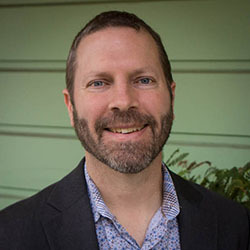
As Interviewer, Marilyn Hamilton, Founder of Integral City commenced her introduction with the memory of the time the two Integral pioneers first met – at the 2004 Integral Ecology & Sustainability Conference in Boulder Colorado.
Marilyn used an Interview Guide adapted from Sean’s own Metaimpact Wisdom Cards and Integral Methodological Pluralism
The questions are below – and the answers can be listened via the podcast – Click the link here.
Interview Questions
DEEP – What makes your heart sing? Tell us a little of what brought you to CIIS and your doctoral work and how your passions have brought you to Edinburgh (and hopefully Findhorn at Easter)?
CLEAR – What practices make you feel fully alive? Give us a glimpse into your daily, weekly, monthly, annual ++ life
WIDE – Who has inspired you to find your purpose & to live on purpose? How have you been influenced by Wilber? David Spangler/Lorians? Morin? Others?
HIGH – How have your environments and ecologies nourished you? Where are they situated? Subtle, (Causal, Non-Dual) Realms as well as geographies?
METAVIEW – What is captivating your attention on the world stage right now? How does your MetaIntegral MetaImpact perspective offer reframes, new insights, hope for your children?
How will you surprise us in the next year(s).
February 19, 2019
Welcome to the Restaurant at the end of ccc19 cChallenge
After 30 days of cChallenge experience, our Meta-Findhorn cChallengers gathered to celebrate and talk about our experiences on Feb. 7 with a World Cafe (not quite the Restaurant at the End of the Universe for fans of Hitchhikers Guide to the Galaxy)– but we enjoyed enough libations and eco-friendly treats to generate lively conversation! (For details on the cChallenge see the ccc19 cChallenge Platform here; and for summary learnings see the Blog series links at the end of this Blog.
We started with Jane Rasbash’s beautiful poem “Nature”.
 Sky, clouds and birds.
Sky, clouds and birds.Lift up thine eyes.
Be amazed.
See beauty wherever you are.
Feel gratitude.
From this blessed place reflect on the suffering in the world. Allow it to emanate throughout your cells without reaction —— practice equanimity whilst acknowledging the suffering and the denial of what we are doing with our modern consumer lifestyles to nature.
How are we collectively practicing as a dominant species to the detriment of other beings?
So painful, feeling the pain, nature is pain, nature is suffering.
Acknowledging what is happening can be a step towards motivating and sustaining a shift to more wholesome behaviours.
And each in our own small way like a ripple on a pond can start to influence our inner and outer worlds, our communities and beyond — slowly without ego.
Step by step may we become in harmony with all beings in the web of life.
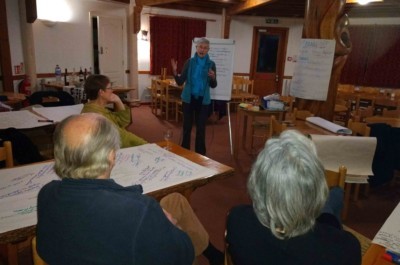
After the inspirations of this poem, we heard from Prof. Karen O’Brien – co-creator of cChallenge and who launched us on January 8, 2019. She explained then and reminded us again how our many posts linked into the Practical, Political & Personal. (Click here to download her powerpoint report: Report – CCC2019 cchange.)
cChallengers Congratulations on Day 30!
Susi’s last post really resonated with me, especially her point that “we are just trying our best and doing what we can.” The idea that we are social beings and parts of larger groups, systems, and structures is so important, and a key to change.
I have been really inspired by the interest and honesty in the posts describing your experiments and experiences with change. I’ve been sharing your stories — and the research and information you have posted.
Conscious change is both an individual and a collective process — the conversations that we have about change are as important as the changes themselves. Thanks to ccc19, F.I.R.E. (and Integral City) for sponsoring and initiating this experiment and holding it so well!!
Karen and the cCHANGE Team
 We had a delicious menu, inspired by our postings on the ccc19 cChallenge platform over the last 30 days. Our conversation became energized around these 3 scrumtious questions:
We had a delicious menu, inspired by our postings on the ccc19 cChallenge platform over the last 30 days. Our conversation became energized around these 3 scrumtious questions:· No Cheese Pizza – What have you done differently in the last month? What changes will endure? What will you let go of?
· Splodge – What systems of Community have you learned about? What would you change?
· Veggie Soup – What would you share at ccc19 (the world) about our cChallenge experiment? What tensions and insights did you/we gain?
We finished up with noticing what patterns had emerged in our relationship with each other and the climate. These were our key points:
Convenience has become viral (like everything packaged in plastic).
Changing our use of plastics requires a systemic change.
We realize how embedded we are in a meta-field.
Community supports our aims.
Individual change and systemic change are interconnected; eg. Choosing to go vegan.
Behaviour change is possible without necessity (i.e. it is not necessary to have top down compulsion to specify change).
This cChallenge was/is an invitation rather than commandment.
Consciousness and free choice lead to change of consciousness.
What motivates people differs. We come from different reasons and starting points.
Ecology of change amplifies our invidividual contribution.
We all have special areas to commit to – we have different ways to engage.
We are not judging about different levels of engagement/commitment.
Do I feel sense of urgency about behaviour change?
We can’t predict the power of change in Personal & Political spheres because any one (or all) of them can lead to unpredictable acceleration.
In USA New Green Deal is an unexpected development.
IF IT AIN’T FUN IT IS NOT SUSTAINABLE.
We are not in fear, rather we have an aspirational/long view.
Change of consciousness.
We experienced Care and Energy in the room.
PostSripts:
Another pattern related to replacing plastic covered products like toilet paper “What the Crap” – does not use plastic.
Saille will offer movement and arts related to Change and Consciousness related to ccc19.
Our final attunement returned to Jane’s poem with the closing lines:
And each in our own small way like a ripple on a pond can start to influence our inner and outer worlds, our communities and beyond — slowly without ego.
Step by step may we become in harmony with all beings in the web of life.
This blog series focuses on the ccc19 cChallenge experiment taking place in the Findhorn Community in 2019. It includes these titles:
How Do You and I Make Drawdown Personal?
cChallenge Draws On & Creates MetaCapitals
New Perspectives on Beauty, Goodness and Truth from ccc19 cChallenge
Meta-Findhorn 4+1 Voices Think Cosmically, Feel Globally, Act Locally
Welcome to the Restaurant at the End of ccc19 cChallenge
Marilyn Hamilton's Blog
- Marilyn Hamilton's profile
- 3 followers


